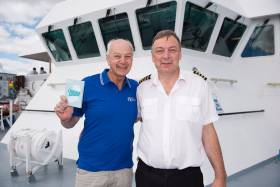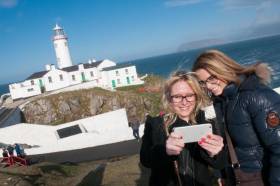Displaying items by tag: Great Lighthouse Festival
The Great Lighthouses of Ireland Partnership, the all-island tourism initiative developed by the Commissioners of Irish Lights, has announced Insomnia Chairman, Entrepreneur and TV and radio personality Bobby Kerr as the new Independent Chairperson to support the project’s development. A keen yachtsman with a passion for all things maritime, Bobby will chair the body which features twelve lighthouses in breath-taking coastal locations from Donegal to Cork and from Antrim to Wexford.
In his first act as Chairperson, Bobby attended Seafest 2017 national maritime festival in Galway where he met with GLI Partners, lighthouse operators, and representatives from the Commissioner of Irish Lights.
Bobby takes up the pro-bono role at an exciting time for Great Lighthouses of Ireland, with the Partnership having recently agreed a new marketing and development strategy up to 2020 with the aim of driving up visitor numbers and growing revenue. The GLI Partnership will benefit from Bobby’s business expertise and understanding of community projects to help in building the profile of the lighthouse properties.
With tourists offered the chance to both visit and stay in a lighthouse, the twelve GLI sites combined attracted some 135,000 visitors in 2016. There are over 19,000 bednights available across the various lighthouses; GLI Partnership is forecasting a 9% growth in visitor numbers and over 60% visitor occupancy in bednights in 2017. Both funding and resources have been committed to position the 12 lighthouses as must see, unique and high quality experiences for domestic and international visitors.
Welcoming Bobby Kerr’s appointment, Chief Executive of Irish Lights, Yvonne Shields commented: “Our maritime heritage is a great source of pride. Through Great Lighthouses of Ireland, Irish Lights has brought together a group of people who are deeply rooted in our coastal communities and hugely committed to our lighthouse heritage, and we are delighted that Bobby Kerr will be working with us to support this leading-edge project.”
“Given the success of this initiative to date, Bobby’s background and experience will be of huge value in guiding and informing the future work plans and objectives of the partnership and we look forward to developing exciting new collaborative initiatives with our lighthouse partners over the next phase of development of the project.”
Speaking as he accepted the invitation to act as Chairperson, Bobby Kerr said: “I’m incredibly excited to be given this unique opportunity to contribute to such a high-profile and imaginative tourism offering as the Great Lighthouses of Ireland.
I am committed to ensuring that this partnership adds value to the national tourism development agenda, partners and coastal communities in a manner that is sustainable and one that we are all proud to be associated with.”
Great Lighthouses of Ireland
Great Lighthouses of Ireland is an all-island tourism initiative, developed by the Commissioners of Irish Lights, the General Lighthouse Authority for the island of Ireland. Featuring twelve lighthouses in breath-taking coastal locations, Great Lighthouses of Ireland offers visitors from home and abroad the chance to visit or stay in a lighthouse, to find out about their history, to appreciate the spectacular natural world around them, to discover the technology at work in lighthouses today and to meet the people who are passionate about these unique places.
Great Lighthouses of Ireland partners include the Irish Landmark Trust, the Royal Society for Protection of Birds, Forbairt Fhanada Teoranta (Fanad Community Group), Clare County Council, Ballycotton Lighthouse Tours, Mid & East Antrim Borough Council, Hook Heritage Limited, Valentia Island Development Company and Clare Island Lighthouse. Great Lighthouses of Ireland is also supported by Tourism Ireland, Fáilte Ireland and Tourism Northern Ireland.
Full list of Great Lighthouses of Ireland:
St John’s Point, Co Donegal
Fanad Head, Co Donegal
Rathlin West Light Seabird Centre, Co Antrim
Black Head, Co Antrim
St John’s Point, Co Down
Wicklow Head, Co Wicklow
Hook, Co Wexford
Ballycotton, Co Cork
Galley Head, Co Cork
Valentia Island, Co Kerry
Loop Head, Co Clare
Clare Island, Co Mayo
#LighthouseFestival - Next weekend is the time... to kick start the Summer with the Great Lighthouses of Ireland May Bank Holiday Festival (29 April – 1 May).
Meet our Lighthouse StoryKeepers, enjoy all things maritime from crafts, technology, food and hear tall tales of hero feats around our coast.
From Hook to Loop, out to the islands of Rathlin, Valentia and Ballycotton to ceol agus craic at Fanad a weekend of discovery, stories and thrills await!
Light up your day at the No.1 flashiest lighthouse in the world according to Lonely Planet - Hook Head Lighthouse in Co. Wexford. Learn more about the maritime history of Irelands Ancient East at a Pirate school taught by Captain Hook and Pirate Pat. Or for the less adventurous, relax with a tour of the lighthouse and try some of lawn games.
Get to the award-winning peninsula at Loop in Co. Clare, take the tour to the top of our iconic lighthouse for unrivalled vistas and take time on the ground to taste the best local food, see the local crafts and discover its fantastic maritime heritage
Take the Rathlin Island ferry and go to the West Light ‘upside-down’ lighthouse in Co. Antrim to welcome back the puffins and the tens of thousands of visiting birds like kittiwakes and razorbills nesting around the cliffs. With lots of family fun activities planned, an unforgettable trip is on the cards.
See the stars at Valentia in Co. Kerry, home of the dark skies, and hear tales of war and conquest long before Star Wars! Capture the best memories on lighthouse photography tours at Fanad in Co. Donegal, voted one of the most beautiful lighthouses in world.
Or learn how to cook seaweed – a new family treat! Enjoy East Cork and listen to the tales and stories of Lighthouse Keeping on Ballycotton Island.
Coastal partners and organisations such as Royal National Lifeboat Institute (RNLI) Coastguard and others will be onsite for demonstrations and talks in many of the locations Get tips on being safe and enjoying our coast this summer, explore our towers, discover their hidden secrets and much more.
With many of our Great Lighthouses along the Wild Atlantic Way: see website, Fiona Monaghan, Head of Wild Atlantic Way at Failte Ireland said: “This is the weekend to embrace the Wild Atlantic Way and discover the stories of the lighthouses and their communities. We in Failte Ireland are delighted to support this event as it encourages visitors to experience the wonders of life shaped by the sea and to meet with the people who are passionate about these unique places”
Great Lighthouses of Ireland is an exciting collaboration between many private and public organisations in coastal communities, lead and supported by Irish Lights
Welcoming the second year of Shine a Light on Summer Festival, Yvonne Shields, Chief Executive of Irish Lights, said; “This is an important event for Irish Lights. We have a long and rich history, and connection to the coast and its communities in our role in providing navigation services for nearly 250 years. As the keepers and custodians of some of the most spectacular maritime heritage properties on the Island of Ireland we are encouraging everyone to come and enjoy all that Great Lighthouses of Ireland has to offer this weekend and summer”
As Gerald Butler; Former Lighthouse Keeper & Current Lighthouse Attendant at Galley Head Lighthouse says; “It wasn’t a job – it was a way of life”
For event details and information about and booking Great Lighthouses of Ireland visit: www.greatlighthouses.com/shine-a-light






























































